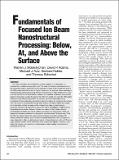| dc.contributor.author | MoberlyChan, Warren J. | |
| dc.contributor.author | Adams, David P. | |
| dc.contributor.author | Aziz, Michael | |
| dc.contributor.author | Hobler, Gerhard | |
| dc.contributor.author | Schenkel, Thomas | |
| dc.date.accessioned | 2009-04-13T19:13:48Z | |
| dc.date.issued | 2007 | |
| dc.identifier.citation | MoberlyChan, Warren J., David P. Adams, Michael J. Aziz, Gerhard Hobler, and Thomas Schenkel. 2007. Fundamentals of focused ion beam nanostructural processing: Below, at, and above the Surface. MRS Bulletin 32(5): 424-432. | en |
| dc.identifier.issn | 0883-7694 | en |
| dc.identifier.uri | http://nrs.harvard.edu/urn-3:HUL.InstRepos:2794940 | |
| dc.description.abstract | This article considers the fundamentals of what happens in a solid when it is impacted by a medium-energy gallium ion. The study of the ion/sample interaction at
the nanometer scale is applicable to most focused ion beam (FIB)–based work even if
the FIB/sample interaction is only a step in the process, for example, micromachining or microelectronics device processing.Whereas the objective in other articles in this issue is to use the FIB tool to characterize a material or to machine a device or transmission electron microscopy sample, the goal of the FIB in this article is to have the FIB/sample interaction itself become the product.To that end, the FIB/sample interaction is
considered in three categories according to geometry:below, at, and above the surface. First, the FIB ions can penetrate the top atom layer(s) and interact below the surface. Ion implantation and ion damage on flat surfaces have been comprehensively examined; however, FIB applications require the further investigation of high doses in three-dimensional profiles.Second, the ions can interact at the surface, where a morphological instability can lead to ripples and surface self-organization, which can depend on boundary conditions for site-specific and compound FIB processing. Third, the FIB may interact above the surface (and/or produce secondary particles that
interact above the surface).Such ion beam–assisted deposition, FIB–CVD (chemical vapor deposition), offers an elaborate complexity in three dimensions with an FIB using a gas injection system. At the nanometer scale, these three regimes—below, at, and above the surface—can require an interdependent understanding to be judiciously controlled by the FIB. | en |
| dc.description.sponsorship | Engineering and Applied Sciences | en |
| dc.language.iso | en_US | en |
| dc.publisher | Materials Research Society | en |
| dc.relation.isversionof | http://www.mrs.org/s_mrs/sec_subscribe.asp?CID=8910&DID=195529&action=detail | en |
| dash.license | LAA | |
| dc.title | Fundamentals of Focused Ion Beam Nanostructural Processing: Below, At, and Above the Surface | en |
| dc.relation.journal | MRS Bulletin | en |
| dash.depositing.author | Aziz, Michael | |
| dc.identifier.doi | https://doi.org/10.1557/mrs2007.66 | |
| dash.contributor.affiliated | Aziz, Michael | |


